|
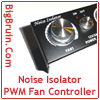 Posted: December 15, 2003 Posted: December 15, 2003
Author: Jason Kohrs
Manufacturer: Noise Isolator
Source: Jab-Tech
The installation of the device was simple, and can be seen as installed into a Enermax CS-10182 case. Once installed and all wired up, I gave the knobs and buttons a few tweaks. The first thing I noticed was that the spinning action of the knobs wasn’t as smooth as other rheobus devices I have used, like metal may have been rubbing on metal. In addition, spinning the knobs a few times made it evident that the chrome skin wasn’t permanently affixed to the base of the knob. As seen in the below right image, the smooth bore of the chrome skin sits on a smooth black base. Although the black base has stops at the minimum and maximum speed settings, the chrome knob can keep spinning, and the little notch intended to indicate speed can be set far from its true position. This minor issue was remedied by a small drop of crazy glue (and if they’re reading this, maybe Noise Isolator will do this before they leave the factory).
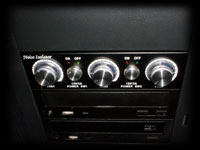 
The Enermax CS-10182 case is an ideal candidate for the Noise Isolator Fan Controller. It features mounts for a total of seven case fans; two in the front, two in the side, two in the rear, and one in the top. I currently have the front, side, and rear fan locations filled, and the three groups of two fans in the case match up perfectly to the two headers found on each of the three channels found on the PWM. The image below shows the inside of the case, with the rear and side pair of fans visible. At the bottom of the image is a RAID controller which leads to two Maxtor hard drives, each of which has a Spire cooler installed. These two coolers aren’t particularly noisy, but hooking them up to the on/off switches will allow me to turn them off when not required.
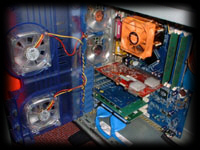
The below images came out rather poorly (don’t bother trying to click them for a larger view), but they roughly detail the lighting scheme found on the Noise Isolator PWM Fan Controller. The image on the left shows the device with the fan speeds set to high, and the two switches turned on. The image on the right shows the device with one switch on, one switch off, and the fan speeds set to low. Although the photos don’t do it justice, the blue halo around each fan speed control knob increases in intensity with increased fan speed. When in the lowest setting, the light is a dull indigo hue, but when ramped all the way it becomes an intense electric blue (which my camera failed to translate). Except for the issues with my camera, the other oddity is that the lighting scheme uses red to indicate on and green to indicate off. Somewhat counter-intuitive to me, but luckily the faces are printed with the white lettering to remind you what each light means.
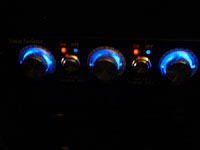 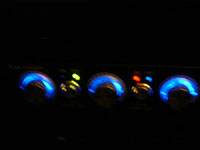
All of the fans installed in the system are rated for 2500 RPM, and Motherboard Monitor 5 provides a full speed reading of about 2575 RPM on the two that are monitored via a motherboard fan header. Spinning the dial from maximum to minimum reduces the speed down to a mere 1550 RPM, virtually eliminating all noise. Setting the dial so that the fans spin at roughly 2250 RPM provided a perfect balance of noise reduction and temperature, as case temperatures were not altered at all.
The Noise Isolator PWM Fan Controller incorporates a few interesting features that are welcome refinements to the relatively simple design of your typical rheobus. The high (20W per channel) power rating, six 3-pin fan headers, and two 12V power switches make this device as functional as it is attractive. The high (20W per channel) power rating, six 3-pin fan headers, and two 12V power switches make this device as functional as it is attractive. Available from Jab-Tech for $21.95 (US), the price is equally attractive, and provides more power and features than other fan controllers that cost about as much, or more!
Although not perfect, the Noise Isolator PWM Fan Controller is an excellent choice for anyone seeking such a device, and is awarded four out of five stars...

Pros:
• High (20W) power output per channel, with a total of six 3-pin fan headers
• Inclusion of two 12V power switches is a nice enhancement to standard rheobus
• Attractive design available in black, silver, and blue
• LEDs provide convenient indication of switch positions and general fan speed
• Competitively priced
Cons:
• Knob’s chrome skin not affixed to the base, remedied by a drop of crazy glue
• Knobs do not have the smoothest spinning action
Special thanks to Jab-Tech for providing the Noise Isolator PWM Fan Controller for review!
Please drop by the BigBruin.Com Forum and feel free to discuss this review.
Page 1 | Page 2 | Forum | Review Index
|